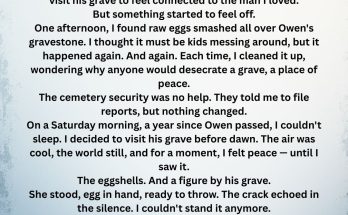When my mother died, the house felt like a room with the lights turned off. Her voice lived in the corners, her apron still hung by the sink, and every small thing reminded me that she had been the center of our world. I didn’t know how to grieve, so I did the only thing that made sense to me: I picked up a brush.
At first I painted the things she loved—the chipped teacup she used every morning, the blue scarf she wrapped around her neck in winter, the crooked chair where she read aloud. Painting became my way of talking to her; each stroke was a sentence, each color a memory. I painted late into the night, the lamp on the table my only witness, and slowly the blank canvases filled with the shape of her life.
People asked why I painted so much. I told them I was trying to remember the way she laughed, the way she hummed while she cooked, the way she smoothed my hair when I was small. I painted to keep her present—not as a photograph, but as something alive and breathing on the canvas. The more I painted, the less the house felt empty.
One afternoon a neighbor knocked and asked to see my work. Another neighbor came the next day. Word spread quietly, like a rumor of comfort. I hung a few pieces in the community center and watched strangers stop and stare. They didn’t just see paint; they saw a life they recognized—loss, love, the small rituals that make a family. The paintings became a place for people to bring their own memories.
I organized a small show with the money I had saved from odd jobs. I didn’t expect much, but the room filled with people who had known my mother, people who had lost someone and found a way to keep them near. We talked, we cried, we laughed at the same stories I had painted. A local teacher asked if she could bring her students to learn about art and memory. A woman bought a painting and told me she would hang it where she could see it every morning.
The show didn’t erase the ache, but it changed it. Grief stopped being a private weight and became something we could share. What began as a way to hold on turned into a way to give back—I used the proceeds to fund art supplies for kids who couldn’t afford them, so they could learn to tell their own stories.
Now, when I stand in front of a blank canvas, I don’t feel lost. I feel like I’m continuing a conversation. The colors I choose are the same ones she loved, and in every brushstroke there is a little of her laugh, a little of her stubborn kindness. Painting taught me that memory can be made into something beautiful, and that love can be carried forward in color.



